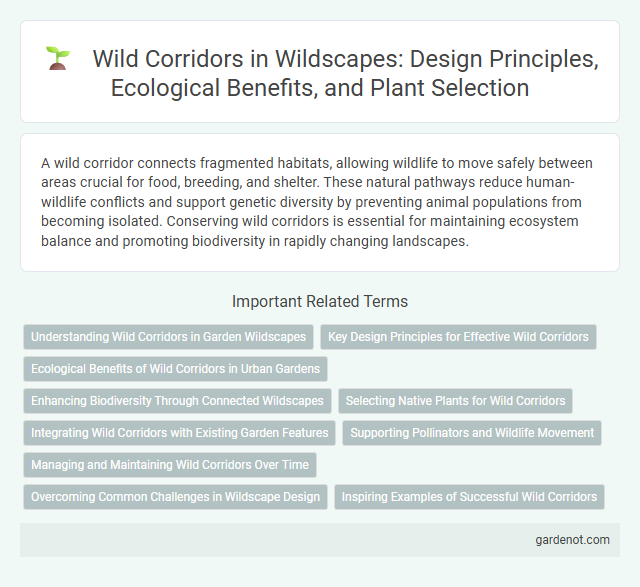A wild corridor connects fragmented habitats, allowing wildlife to move safely between areas crucial for food, breeding, and shelter. These natural pathways reduce human-wildlife conflicts and support genetic diversity by preventing animal populations from becoming isolated. Conserving wild corridors is essential for maintaining ecosystem balance and promoting biodiversity in rapidly changing landscapes.
Understanding Wild Corridors in Garden Wildscapes
Wild corridors in garden wildscapes serve as vital pathways that connect fragmented habitats, allowing wildlife to move safely between feeding, breeding, and shelter areas. These corridors enhance biodiversity by linking isolated green spaces, facilitating gene flow and promoting species survival. Designing corridors with native plants and cover supports pollinators, small mammals, and birds, creating a thriving ecosystem within urban and suburban gardens.
Key Design Principles for Effective Wild Corridors
Wild corridors must prioritize habitat connectivity to allow safe animal movement between fragmented landscapes, reducing genetic isolation and enhancing biodiversity. Incorporating natural vegetation buffers and minimizing human-made barriers supports ecological flow and species migration. Designing corridors with adequate width and structural complexity ensures resilience to environmental changes and fosters sustainable wildlife populations.
Ecological Benefits of Wild Corridors in Urban Gardens
Wild corridors in urban gardens enhance biodiversity by connecting fragmented habitats, allowing native species to migrate and thrive. These corridors improve air and soil quality by supporting diverse plant life, which helps regulate microclimates and reduce urban heat island effects. Functioning as natural filters, wild corridors mitigate pollution and promote ecological resilience, fostering sustainable urban ecosystems.
Enhancing Biodiversity Through Connected Wildscapes
Wild corridors serve as essential links between fragmented habitats, promoting gene flow and species migration that enhance overall biodiversity. These connected wildscapes reduce habitat isolation, increase species survival rates, and support ecosystem resilience in the face of environmental changes. Implementing wild corridors contributes to the restoration of ecological networks critical for maintaining wildlife populations and ecosystem services.
Selecting Native Plants for Wild Corridors
Selecting native plants for wild corridors enhances biodiversity by providing essential habitats and food sources for local wildlife. Native species such as milkweed, goldenrod, and coneflower support pollinators and improve ecological resilience against invasive plants. Incorporating a diverse mix of shrubs, grasses, and flowering plants ensures year-round cover and nourishment within wild corridors.
Integrating Wild Corridors with Existing Garden Features
Wild corridors enhance biodiversity by seamlessly integrating with existing garden features such as native plant beds, water elements, and natural stone paths. Designing these corridors involves using native flora to create continuous habitats that connect isolated green spaces while supporting pollinators and wildlife movement. Strategic placement near garden edges and through underutilized areas maximizes ecological benefits without disrupting aesthetic or recreational functions.
Supporting Pollinators and Wildlife Movement
Wild corridors enhance ecological connectivity by providing continuous habitats that support pollinators such as bees, butterflies, and hummingbirds essential for plant reproduction. These corridors facilitate safe wildlife movement, reducing habitat fragmentation and allowing genetic exchange among animal populations. Effective design includes native flowering plants and shelter, ensuring resources and protection for diverse species throughout seasonal changes.
Managing and Maintaining Wild Corridors Over Time
Managing and maintaining wild corridors over time involves continuous monitoring of vegetation, wildlife activity, and potential human disturbances to ensure habitat connectivity and biodiversity preservation. Restoration efforts include planting native species, controlling invasive plants, and repairing any structural damages like broken fences or erosion issues. Employing adaptive management strategies based on ecological data helps sustain corridor functionality and promotes long-term ecological resilience in Wildscape environments.
Overcoming Common Challenges in Wildscape Design
Wild corridors in Wildscape design face common challenges such as habitat fragmentation, human-wildlife conflicts, and invasive species management. Effective strategies include enhancing vegetation connectivity, implementing wildlife-friendly fencing, and monitoring ecosystem health to ensure safe passage for native species. Integrating community involvement and adaptive management techniques optimizes corridor functionality and supports biodiversity conservation.
Inspiring Examples of Successful Wild Corridors
Wild corridors, such as the Yellowstone to Yukon initiative, demonstrate remarkable success in connecting fragmented habitats for wildlife movement. Studies from the Mesoamerican Biological Corridor reveal significant boosts in biodiversity and species migration facilitated by well-managed ecological pathways. These inspiring examples underscore the crucial role wild corridors play in preserving genetic diversity and ensuring ecosystem resilience.
Wild corridor Infographic

 gardenot.com
gardenot.com